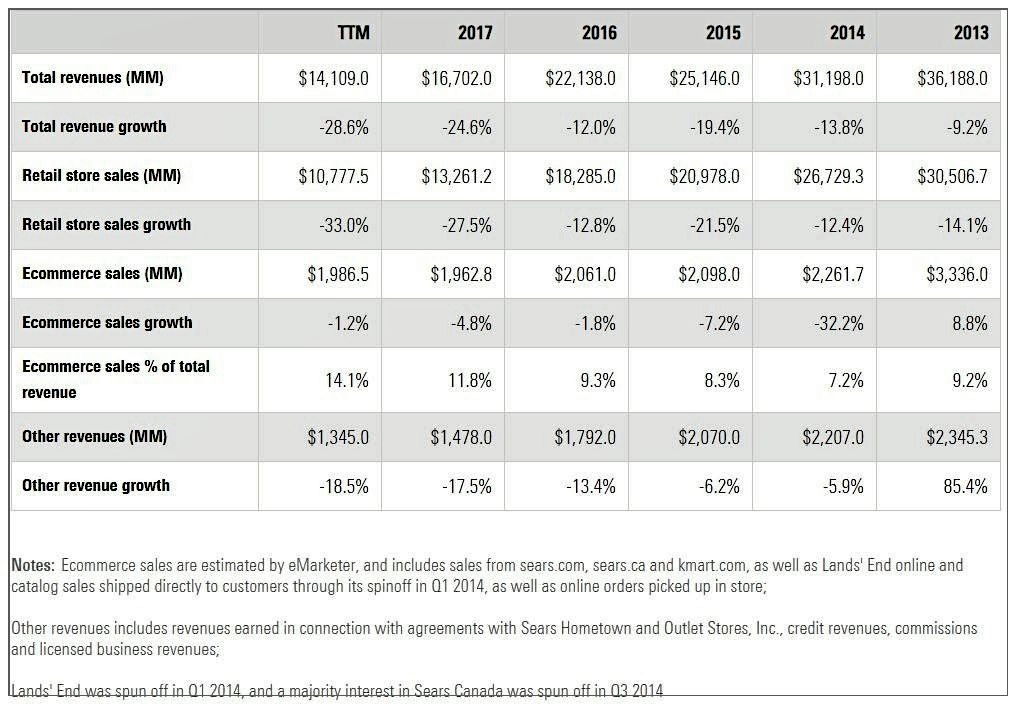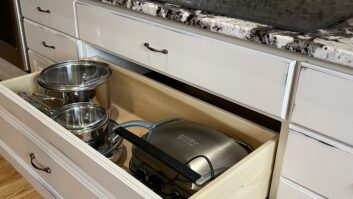Sears’ long-anticipated Chapter 11 filing, which arrived this morning in a federal bankruptcy court in White Plains, N.Y., after 10 straight years of losses, came as no surprise to the company’s vendors and retail competitors.
As the parent of Sears and Kmart lurched closer to insolvency, appliance manufacturers reduced their OEM and retail exposure to the business, while merchants peeled off points of market share by stepping up their sales and marketing games.
Whirlpool, for one, pulled back from Sears nearly one year ago, when an impasse over pricing led to its brand-family’s departure from the retailer’s sales floors.
See: The End Of A Beautiful Friendship
However, the company continued to make its private-label Kenmore appliances, ostensibly leading to its listing as Sears’ seventh-largest unsecured creditor, with $23.4 million in unsecured claims.
But in a filing of its own this morning, Whirlpool described its remaining Sears inventory as “immaterial”; its net sales to Sears as less than 2 percent of its global net sales; and the $30 million it’s owed in total as about 1 percent of its aggregate accounts receivable exposure.
“We believe the Sears bankruptcy will have a very limited short-term impact on our results of operations as consumers adjust to the new retail landscape and we work through the one-time impact of accounts receivable and inventory write off,” the company said in its 8K filing.
It also shrugged off the long-term impact of the bankruptcy, noting: “In the past, when faced with a potential volume reduction from any one particular segment of our trade distribution network, we generally have been able to offset such declines through increased sales throughout our broad distribution network.”
Specifically, said Joe Liotine, president of Whirlpool North America, “Our products are sold where consumers want to shop, with distribution across all big-box retailers, the homebuilding channel and independent retailers.”
Similarly, Electrolux, listed as Sears’ eighth-largest unsecured creditor with $18.6 million in unsecured claims, said it “has been actively planning for various Sears’ contingencies while also growing the business with other customers” and, like Whirlpool, described the immediate impact of the bankruptcy as immaterial.
(Daewoo is Sears’ ninth-largest unsecured creditor, owed $15.2 million, and Samsung’s U.S. home appliance unit is ranked 13th with $8 million in unsecured claims, the bankruptcy filing shows.)
That said, Electrolux’s North American majap unit derives about 10 percent of its total revenues from Sears, and plans to work with the company’s newly named chief restructuring officer Moshin Meghji — managing partner of restructuring advisory firm M-III Partners, which prepared Sears’ Chapter 11 filing — “to explore the prospects of continuing its business with Sears while continuing to manage the financial and operational exposure.”
For those reasons, Electrolux said it can’t rule out the possibility of a material impact on future sales and earnings.
Sears’ Long Decent Into Bankruptcy

For majap retailers, however, Sears’ long, steady slide into bankruptcy is a gift that keeps on giving. As Best Buy CEO Hubert Joly said last month on a second-quarter earnings call, regarding the company’s appliance business: “There’s a significant change in the competitive landscape and significant tailwind from the competitive situation. And so we believe our revenue growth is principally driven by the continued strength in the category … and the market share gains, which themselves are driven by the competitive situation.”
To help achieve those gains, as reflected in Best Buy’s 10.3 percent appliance comp increase for the period ended Aug. 4, the company has made continual improvements in appliance “proficiency,” as a result of investments in specialty labor, the supply chain and other areas, Joly said.
Likewise, independent dealers, through their buying groups, have not been sitting by idly. The Nationwide Marketing Group, for one, developed a “Prepare For Share” local market analysis program that provided tailored merchandising strategies and in-store marketing collateral to help members reap Sears’ customers and sales.
See: Nationwide Siphoning Sears, hhgregg Shoppers
Still, UBS analyst Michael Lasser earlier this year identified Best Buy, Lowe’s and The Home Depot as the biggest beneficiaries of Sears’ decline, citing an 80 percent overlap with Sears stores located within a 15-minute drive of their own. Lowe’s, Home Depot and Best Buy are the first-, second- and third-largest appliance retailers in the nation, according to TWICE’s Top 50 Major Appliance Retailers ranking, followed by Sears at No. 4.
But to hear Sears tell it, they’re down but not yet out — although chairman and chief investor Eddie Lampert is, at least as CEO. Under the bankruptcy plan, that position has been replaced by an office of the CEO, comprised of chief financial officer Robert Riecker, chief digital officer Leena Munjal, and apparel/footwear president Gregory Ladley.
Lampert, who helped keep the company afloat with asset sales and loans through his ESL Investments hedge fund, failed at efforts to keep the restructuring outside bankruptcy court. His company will now kick in $300 million in debtor-in-possession financing, on top of another $300 million received from leading lenders, pending court approval. The funds will keep the company open for business, at least through the holiday selling season.
ESL, which is both Sears’ largest shareholder and creditor, is also in discussion with the company to enter a stalking-horse bid for “a large portion” of its approximately 700 remaining Sears and Kmart stores. The retailer operated about 3,500 locations when Lampert-owned Kmart acquired Sears in 2005.
As part of the restructuring plan the company will close another 142 unprofitable stores near the end of the year and will begin liquidation sales there shortly. The closures follow a current 46-store shutdown that’s expected to be completed next month.
The goal, said Sears, “is to emerge as a member-centric company, reorganized around a smaller platform of profitable stores, with the capital needed to allow us to prosper in the future.”
Whether Sears can successfully emerge from Chapter 11 as a viable business remains to be seen, although the history of big-box bankruptcies is littered with the empty storefronts of Circuit City, CompUSA, hhgregg and, most recently, Toys “R” Us.
See: How Not To Become The Next Toys “R” Us
Founded in 1893 by Richard Warren Sears and Alvah Curtis Roebuck, Sears was essentially America’s first Amazon, supplying the then rural nation with all manner of goods through its essential mail-order catalog.
By the late 1940s Sears began plying the burgeoning post-war middle class with TVs, lawn mowers and appliances from suburban stores that helped remake the U.S. landscape and define the baby boom years.
While Sears’ decline will likely be studied and debated in business-school classes for years to come, it was largely brought about by a combination of e-commerce competition, declining shopping mall traffic, a dearth of reinvestment, the sell-off of assets, insurmountable financial obligations and, ultimately, its growing irrelevance to a new generation of shoppers.












